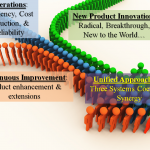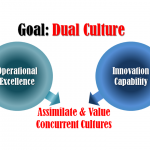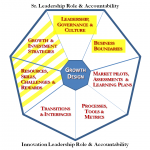Even after 20 years of study, it appears that innovation management is still in its infancy. Based on my experience, large companies are regressing in their ability to effectively innovate.
Processes that people tend to think are critical for an effective, efficient, low cost competitive business tend to stifle innovation, especially the game changing moves. This should not come as a surprise. Innovation strives to change the way things are and operational excellence strives to nail down variability and to build consistency and perfection all at lower cost. Leading innovation requires the ability to effectively manage ambiguity and uncertainty; the opposite is required in operational excellence. It is no wonder that companies have a hard time effectively managing these dual cultures in their businesses and instilling this capability in their leaders. The literature is riddled with companies starting innovation initiatives, investing massive dollars, only to have the initiative underperform and fade away in 4 to 7 years. Thus, we need to look much deeper to better understand why large companies are not being more successful in generating organic growth.
At Strategic Innovation Group, we have developed a Growth Design Model that breaks down the complexity of the innovation system into useful building blocks. It requires the establishment of a dual culture to embrace and legitimize both innovation and operational excellence. The innovation system and the dual culture must be healthy to provide significant benefits. All seven elements of the Growth Design model need to be in place and functioning for corporations to successful embed innovation into their culture and not depend on the brute force of a few champions to carry to market new products and services. The accountability for these Growth Design elements is shared between Senior Executives and the Innovation leaders and their teams.
BACKGROUND: Innovation has been the top issue keeping Industrial Research Institute members awake at night for more than 15 years. As many of you have, I successfully managed all phases of innovation for 33 years prior to starting my consulting business. We all know how to discover opportunities, how to match opportunities with products or services, and test these products and services in order to fine tune the offering. In testing it, we assess business model options and potentials, examining the supply chain in an effort to discover how to extract the greatest value. Why is innovation not returning on investment? The causes of subpar performance appear to be a lack of sufficient involvement of Senior Executive Leadership in innovation and not having the necessary elements and structures in place in the organization to ensure lasting success.
In May 2011, the McKinsey Quarterly cited a key factor for limited organic growth being Senior Leadership not tackling the tough issues of organizational needs sufficiently to drive innovation. The result can be devastating for the innovation team, frustration for the CEO Suite and limiting in shareholder value. These deficiencies cannot be changed overnight. It takes years for Senior Executive Leadership to gain the creditability to positively influence company culture.
Some steps can make a difference immediately, as follows:
- The most important issue for Senior Executives should be organizational needs and adaptations. The organization’s structure is very important.
- Next create an innovation strategy that will coexist with the operations business and that both strategies and cultures are explicit in the corporate strategy.
- You will also need a careful definition of the business boundaries to guide innovation effectively and eliminate waste.
Contact us if you would like our help in building a more effective and profitable innovation capability in your company.
Alan Ayers



